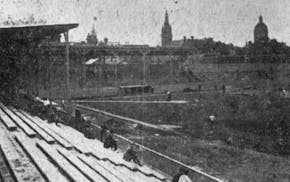The tombstone at New Ulm City Cemetery for Prussian-born baker Jacob Castor, engraved in his native German, says he was "murdered by the Indians on 23 August 1862″ during the U.S.-Dakota War.
Truth is, it was Castor's fellow settlers who accidentally shot him as the war flamed through southern Minnesota in late summer 162 years ago.
In the damp twilight of Aug. 23, 1862, after the second day of clashes in New Ulm, Castor scurried from behind the barricades to fetch some bread from his bakery. But first he tossed a blanket over his shoulders to either fend off the rain or avoid detection. That was a mistake.
"Some of the armed men in a building with port holes mistook him for an Indian and fired at him," according to "Eight Days in August," a 2012 book by Darla Gebhard and John Isch about how the war unfolded in Brown County.
Wounded, Castor was struggling to stand and enter his home when he was again shot by friendly fire. He died the next morning with four wounds in his chest.
Castor, 30, had emigrated from Prussia 19 years before and gotten married in Chicago before moving to New Ulm in 1857, one year before Minnesota statehood and five years before the U.S.-Dakota War erupted.
While the Civil War raged in the East, some Dakota warriors tried to win back their land after broken treaties forced them into a small reservation along the Minnesota River and left them hungry amid delayed annuity payments.
Castor became one of at least three settlers whose friendly-fire deaths were attributed to their wearing blankets, according to the Sept. 20, 1862, edition of the Mankato Semi-Weekly Record. The story noted that one man in New Ulm (likely Castor) and two in St. Peter, "with blankets over their shoulders were mistaken for Indians and shot." It strongly advised settlers against wearing blankets or large shawls at night.
"Jacob Castor was an ordinary guy who was doing what he knew how to do — bake bread — to help his friends and neighbors," said Nancy Noyes Silcox, a Northfield writer whose new book, "A Place Called Home," includes a cameo appearance by Castor. "Had it not been raining and had he not covered himself with a blanket, he might not have been mistaken for a Dakota and shot. He should be remembered for his act of kindness."
Silcox's book is a fictional account of a German immigrant family moving from Cincinnati to New Ulm, but it's peppered with real characters and includes fact-filled appendices that provide a historical timeline and context to better understand the war.
"What has always interested me is how unpredictable life is and how people are caught up in things they never expected and make decisions that have consequences, some good and some bad,'' said Silcox, 79, who was born in Fergus Falls, Minn., and grew up in New Ulm before graduating from the University of Minnesota, serving in the Peace Corps and working as a school librarian in Egypt, Belgium and Ukraine.
Silcox will discuss her new book Sept. 14 at the public library in St. Peter at 10 a.m. and Henderson at 2 p.m. She'll also make a presentation to the annual Minnesota Education Association conference on Oct. 17 in St. Paul.
Though estimates vary, roughly 500 white settlers and soldiers were killed in the 1862 war along with more than 150 Dakota on the battlefield. At the end of the war, about 2,000 Dakota were interned at Ft. Snelling, and 38 Dakota — most of them declared after nominal trials to be guilty of civilian massacre — were executed by hanging in Mankato, still the largest simultaneous mass execution in United States history.
"The population of New Ulm was 640 in 1862, but by the time settlers from the outlying areas flooded in, there were roughly 2,000 people and they needed to be fed before evacuating on the seventh day of the war," said Gebhard, a research librarian at the Brown County Historical Society in New Ulm for nearly 50 years.
Gebhard said that Capt. John Bellm, a commander of New Ulm's volunteer militia, "obfuscated" the details of Castor's friendly-fire death in an effort to win a pension for Castor's widow, Elizabeth. He wrote that Castor was shot four times — "wounds received as a Soldier and while in the line of duty" — but never mentioned the friendly fire.
There are no known pictures of Castor, who was survived by Elizabeth, son Edward and daughter Minna, all of whom fled New Ulm in an ox cart. They were among 23 war widows and 57 children who went to St. Paul, according to the St. Paul Daily Union in December 1862. The story mentioned that the Castor family shared a basement room with another widow and child below a grocery store at 5th and Robert streets, and that all the children were "sick with the measles."
Elizabeth gave birth a short time later to her third child, who died from the measles. She married a cabinet maker three years after the 1862 war and lived until 1914, dying at 77. Like her first husband, she's also buried in New Ulm City Cemetery.
Her son Edward became a jeweler in Waseca but often returned to New Ulm for Junior Pioneer banquets. When he died in 1941 at 84, he was thought to be one of the last survivors of the U.S.-Dakota War.
By then it had been nearly 80 years since his father went out to grab some bread with a blanket over his shoulders and fell to friendly fire.
"It was a tragic end for the well-intentioned Castor," researcher Curtis Dahlin wrote in his 2007 book, "Dakota Uprising Victims: Gravestones and Stories."
Curt Brown's tales about Minnesota's history appear every other Sunday. Readers can send him ideas and suggestions at mnhistory@startribune.com. His latest book looks at 1918 Minnesota, when flu, war and fires converged: strib.mn/MN1918.
Man charged with murder in January death of Jordan woman

Celebrity Wolves fans spotted at Game 3

A history buff's quest to mark St. Paul's 'pillbox' ballpark
Prostate experts see familiar scenario in Biden's cancer diagnosis

